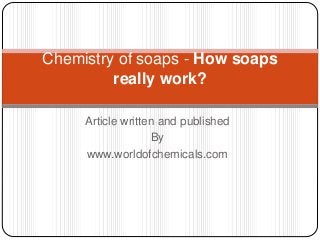
Chemistry of soaps
- 1. Article written and published By www.worldofchemicals.com Chemistry of soaps - How soaps really work?
- 2. What are soaps? Soaps are sodium or potassium salts of fatty acids. They are produced from the hydrolysis of natural oils or fats in a chemical reaction called saponification. Soap is an excellent cleanser which often occurs in form of solid bars or in liquid form. Chemicals in soaps fatty acids, soaps, saponification, tallow, palm kernel oil, sodium chloride, pentasodium pentetate, emulsifier, hydrocarbon chains, lye
- 3. History of soaps The soap making can be dated back to 2800 B.C., with the evidence of Babylonians mastering in the art of soap making. They made soap from fats boiled with ashes. Soap was used in cleaning wool and cotton used in textile manufacture and was used medicinally for at least 5000 years. Ancient Egyptians mixed animal and vegetable oils with alkaline salts to produce a soap-like substance. The Phoenicians used goat’s tallow and wood ashes to create soap in 600BC. Early Romans made soaps in the first century A.D.
- 4. Chemical composition of soaps Soap is salt of fatty acid. Various ingredients present in soaps are – Water keeps the soap from becoming too brittle Coconut oil or palm kernel oil - sodium salts of fats tallow Hydrogenated tallow acid, coconut acid, glycerin – act as skin conditioner Sodium chloride - salt is added to precipitate the soap after saponification Pentasodium pentetate - prevents minerals such as calcium and magnesium in hard water from binding to the soap and affecting the foaming and cleaning performance. pentaerythrityl tetra-di-t-butyl hydroxyhydrocinnamate - antioxidant that inhibits reactions promoted by oxygen that could cause the unsaturated fats in the soap to become rancid. D&C green No. 8, FD&C Green No. 3 - green dyes Titanium dioxide - white pigment that serves to give a lighter color to the soap and modify the color obtained from the use of the green dyes.
- 5. Working mechanism of soaps Soap acts as an emulsifier, which makes it an excellent cleansing agent. An emulsifier is capable of dispersing one liquid into another immiscible liquid. Soap molecule has an ionic and non-ionic part, the non-ionic part (hydrocarbon chain) doesn’t naturally mix with water, soap can suspend oil/dirt in such a way that it can be removed. The organic part of a natural soap is a negatively- charged, polar molecule. Its hydrophilic (water-loving) carboxylate group (-CO2) interacts with water molecules via ion-dipole interactions and hydrogen bonding. The hydrophobic (water-fearing) part of a soap molecule, its long, nonpolar hydrocarbon chain, does not interact with water molecules. The hydrocarbon chains are attracted to each other by dispersion forces and cluster together, forming structures called micelles.
- 6. Working mechanism of soaps cont.. n these micelles, the carboxylate groups form a negatively-charged spherical surface, with the hydrocarbon chains inside the sphere. Because they are negatively charged, soap micelles repel each other and remain dispersed in water. Grease and oil are nonpolar and insoluble in water. When soap and soiling oils are mixed, the nonpolar hydrocarbon portion of the micelles break up the nonpolar oil molecules. A different type of micelle then forms, with nonpolar soiling molecules in the centre. Thus, grease and oil and the ‘dirt’ attached to them are caught inside the micelle and can be rinsed away.
- 7. Applications of soaps Used as skin cleaner Used in laundry for cleaning textiles. Drive nails easier with less risk of splitting the wood, by first rubbing it on the nail shank. Keep garden bugs off plant leaves by mixing it with water and spraying the solution on the leaves' undersides. Soap and water works as well as anything to repel fleas, and the fleas will drown in the water. Soap is alkaline, and combined with some minerals such as baking soda, borax, or washing soda, it succeeds in a number of different all-purpose cleaning tasks Remove wallpaper glue by mixing with warm water and sponging it on the walls.
- 8. Health risks associated with soap making industry There are three main ingredients in plain soap - oil or fat, lye (or alkali) and water. Lyes are extremely caustic. They cause burns if splashed on the skin and can cause blindness if splashed in the eye. If drunk, they can be fatal. Care is needed when handling lyes. Because of these dangers, keep small children away from the processing room while soap is being made. You should always take precautions when handling these materials as they are dangerous. Be especially careful when adding them to cold water, when stirring lye water, and when pouring the liquid soap into moulds. Lyes produce harmful fumes, so stand back and avert your head while the lye is dissolving. Do not breath lye fumes. It is worth investing in a pair of rubber gloves and plastic safety goggles. You should also wear an apron or overalls to protect your clothes. If lye splashes onto the skin or into your eyes, wash it off immediately with plenty of cold water. When lye is added to water the chemical reaction quickly heats the water. Never add lye to hot water because it can boil over and scald your skin. Never add water to lye because it could react violently and splash over you.
